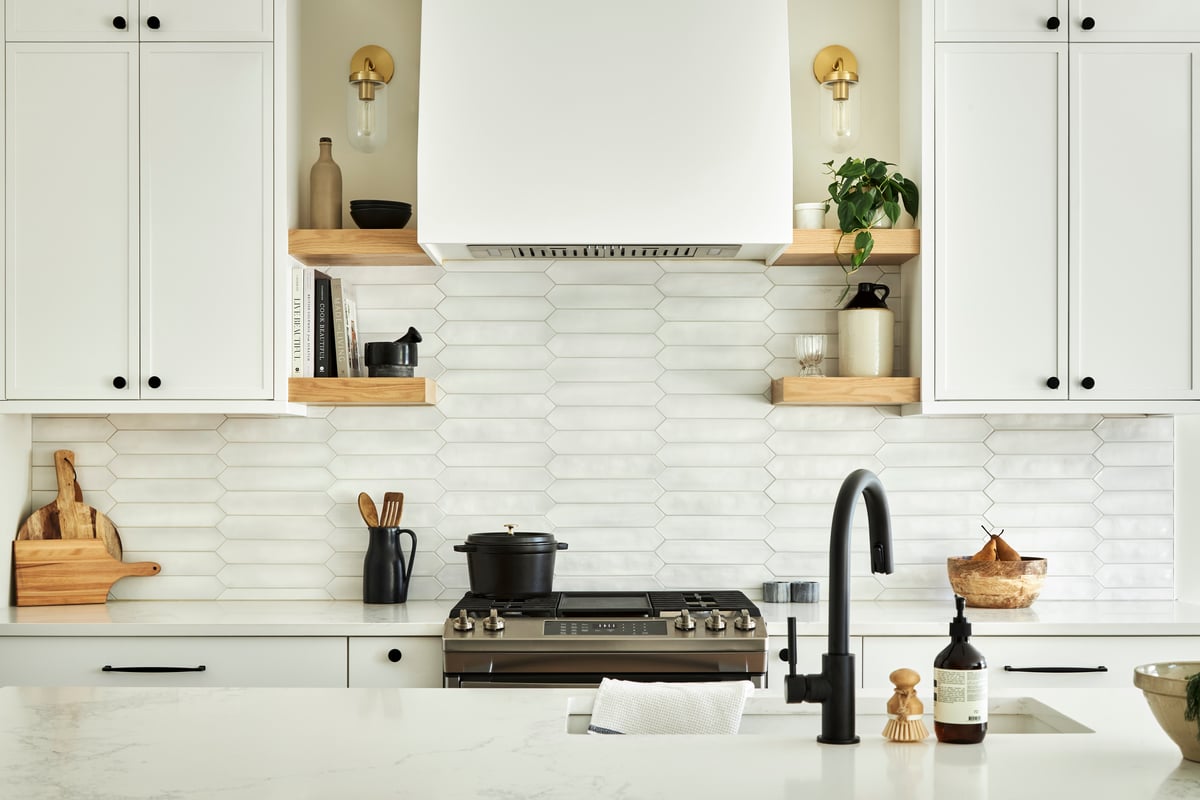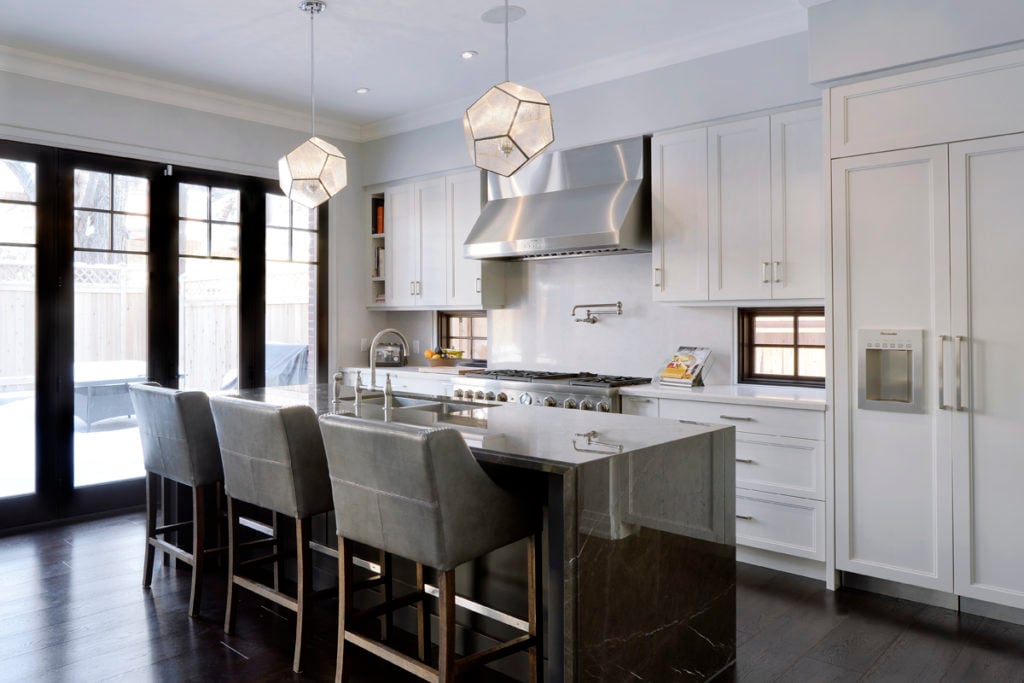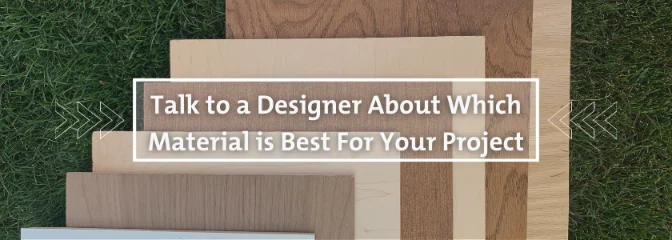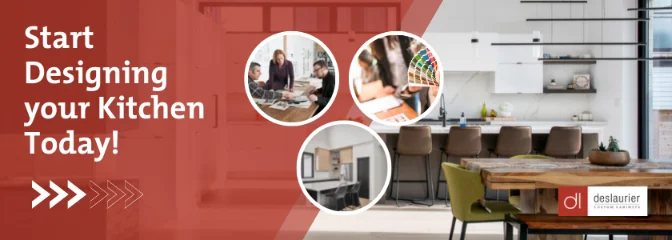3/06/2022 • Blog, Product Reviews, Design Tips, Problems
8 Popular Kitchen Materials with Issues You Should Know About
Estimated Read Time: 8 Minutes
When you research kitchen materials online, you’re bombarded with “best of” and “top 10” lists that highlight positive features and all the good that comes with designing your dream kitchen.
Which is great! You should want to find quality products for your kitchen that are revered by industry experts.
But what about the not so enthusiastic side of kitchen materials?
At Deslaurier, we’re experts when it comes to custom cabinets and all things kitchen design. As we’ve often gone into detail on the positives, like the most durable kitchen materials or luxurious cabinets, we thought we’d also share the unfavourable aspects of kitchen materials that aren't regularly highlighted.
With that, this article will feature a number of popular kitchen building materials, from cabinets to flooring, that have issues or concerns you should know about before penciling them in for your kitchen design.
Let’s get started!
|
Table of Contents |
|
What Do We Mean by “Concerns”? Kitchen Flooring Materials |
What Do We Mean by “Concerns”?
These materials aren’t inherently bad or things you should avoid entirely. No building material is perfect – if they were, there wouldn’t be such a large variety to choose from!
The purpose of this article is to highlight flaws or durability concerns that homeowners should be aware of regarding commonly used kitchen materials.
At Deslaurier, we’ve designed countless kitchens with every material listed below. The materials mentioned in this article are merely products that have potential drawbacks or vulnerabilities that might not be appropriate for every kitchen.
After all, each homeowner is unique. You may be an avid chef with a house full of kids and pets, or live alone and don’t cook very often. The materials you select in your kitchen should reflect not only your preferred aesthetic taste, but also adhere to your daily lifestyle as well.

Kitchen Cabinet Materials
Kitchen cabinets are undoubtedly the largest investment you’ll make in your kitchen design. Depending on the size and layout of your space, it can easily cost tens of thousands of dollars to outfit a kitchen with cabinetry, let alone high-quality custom cabinets.
For that reason, it’s crucial that you’re privy to everything you need to know about the particular material(s) you select to furnish your cabinets with. You wouldn’t want to spend $20,000 worth of cabinetry only to find out the material you chose doesn’t mesh well with your household dynamic or cooking style.
1. Issues with Painted MDF Cabinets
When it comes to a painted finish, MDF kitchen cabinets are in a league of their own. Their smooth surface is superior to paint-grade natural woods like birch or maple.
The downside, however, is that once the finish is applied to the cabinet, painted MDF can be vulnerable to dents and scratches. That being said, no one intends on subjecting their cabinet doors to impact damage, so having painted MDF instead of wood is anything but a detriment.
Instead, let’s focus on the biggest concern to MDF cabinets: water damage.
Water will always try to find its way into any surface – even at a molecular level – and once it’s in, it will spread like wildfire. If exposed to a pronounced amount of liquid or moisture, MDF doors can become soggy and begin to disintegrate.
That’s where impact damage comes into play. If an MDF door’s painted finish is chipped or dented and the underlying substrate becomes compromised, water will become enemy number one.
This isn’t to sway you from MDF cabinetry. As we said, you won’t find a better cabinet material for a smooth, uniform painted finish. These are just important factors to stress to potential consumers so they know the characteristics of every material that goes into their kitchen.
2. Problems with Thermofoil Cabinets
Thermofoil cabinets (thermo) is a PVC vinyl material that is applied to MDF doors through heat and vacuum pressure, fusing the two together. The thermofoil process produces a seamless surface and creates a visual aesthetic that rivals painted cabinets.
In terms of impact damage, the plastic coating of thermofoil performs admirably and outshines painted MDF cabinets. Their primary issue, however, is something that is commonplace in a kitchen: vulnerability to heat and steam.
High temperatures can cause the thermofoil to delaminate from the door and essentially “unstick” from the surface.
Thermo exposed to a pronounced amount of steam can melt, peel, or blister. That is the biggest maintenance-related complaint from consumers and an issue you need to be prepared for before purchasing thermofoil cabinets.
Thankfully, thermofoil cabinets placed next to high-heat appliances like ovens can be equipped with thermofoil heat shields for additional protection.
While they do have impressive longevity if properly maintained, the fact that heat and steam – two things that are commonplace in a kitchen – cause such an issue for thermo is a pause for concern. For that reason, most thermofoil cabinets don’t last much longer than 10 to 15 years.
Want a perfect kitchen customized for your unique lifestyle? Being your journey today and book a free consultation with a Deslaurier kitchen expert!
Kitchen countertops
Equal parts function and design statement, the countertop surface you choose can impact your kitchen in a number of ways. Some homeowners may lean towards the appearance of their countertop while others may focus on how the surface will coexist with their cooking style.
Whichever factors you choose to prioritize for your kitchen countertop, it’s vital to have as much information as possible before purchasing your countertop surfaces.
3. Problems with Laminate Countertops
To their credit, the laminate manufacturing process has made leaps and bounds in recent years. Modern-day laminate can convincingly replicate the appearance of anything from a hardwood species to a natural stone, with some suppliers offering over 500 different selections!
However, when it comes to budget-friendly materials like laminate countertops, there’s almost always a reason they come at the price point they do.
With all their improvements – they truly are a much better product than they were even just a decade ago – laminate countertops still have a number of durability concerns that every potential consumer should know about.
Laminate is actually one of the least heat-resistant materials for a countertop. Hot pans and grease splatters are common heat issues that can be detrimental to laminate surfaces
The substrate is significantly susceptible to water and, if exposed to a pronounced amount, can easily result in the entire countertop needing to be replaced. They also aren’t very formidable against scratches or impact damage.
For these reasons, laminate countertops are often replaced after roughly 7 years of use. However, when factoring in their affordability compared to other countertop materials, they’re certainly worth the short-term investment.
4. Issues with Marble Countertops
You might be wondering what such a luxurious, high-end product like marble countertops is doing on this list. Having such a prestigious, grandiose reputation, not enough is mentioned about marble’s high-maintenance characteristics and durability concerns.
The main selling factor about marble is undoubtedly the look. Marble countertops have stunning appearances that immediately catch your eye.

What often isn’t mentioned about marble, however, is that it is far from the most practical countertop surface. There are a number of characteristics that make it arguably the most high-maintenance countertop material available.
Marble is a very soft stone, so you have to be cautious in order to prevent scratches and marks.
Marble countertops are also susceptible to “etching”: a damaging effect caused by acids. Commonplace kitchen items like lemon juice or vinegar can wear down the vulnerable stone surface if they have prolonged contact.
Marble is what’s known as a “porous” stone, which means it requires periodical resealing in order to prevent water damage. Unlike granite, another porous stone that needs resealing only once a year, marble countertops need to be resealed as often as every 3 months!
Ultimately, you’re purchasing marble countertops for the look. Even without the maintenance concerns, the price tag of marble isn’t for everyone: outfitting a kitchen’s surfaces with marble can easily surpass $10,000.
At that cost, you don’t want to worry about performance issues.
Kitchen Sink Materials
Most people underestimate how important choosing the right sink for your kitchen can be. Whether it’s for meal prep, soaking pots and pans, or just washing up, the kitchen sink is used multiple times a day.
5. Enameled Cast-iron
Cast-iron is one of the strongest and most durable materials of any kitchen sink. While this is beneficial, it will rust when exposed to moisture (which is inevitable in the kitchen). If you want a cast-iron kitchen sink, it is crucial that you ensure it has been coated using porcelain enamel.
Although enameled cast-iron sinks are durable, they can be prone to scratching or chipping if a heavy item is dropped.
It is also important that you are cautious and diligent when you clean the sink. If you use something acidic or abrasive, and there is a chip or scratch deep enough that the cast iron is exposed, your sink can easily rust.
One final thing on enameled cast-iron sinks. They are extremely heavy and can weigh almost 3 times as much as stainless steel! Due to their excessive weight, you may be required to reinforce your cabinets and countertops to ensure they can support such a dense material.
6. Stainless steel
Speaking of stainless steel sinks, it’s hard to beat their combination of versatility, durability, and affordability. In fact, quality stainless steel is one of the best kitchen sink materials you can find thanks to the material's resistance to corrosion, rust, heat, and high impact.
However, problems arise when stainless steel sinks are made in a low-quality, thin gauge.
If so, they can become vulnerable to scratches and stains. Their quality will of course depend on the manufacturer, but the lower the gauge number (typically ranging from 20 to 14) the thicker the stainless steel will be.
If you do find a quality stainless steel sink – and there are plenty out there – you won’t be disappointed with the product!
Kitchen Flooring
With so much daily foot traffic in the kitchen, it’s important to install the right flooring product to fit your household activity.
Let’s discuss two man-made products: vinyl and laminate. Each can replicate the look of hardwood and even tile, but may have underlying issues you should be cognizant of.
7. Vinyl Flooring Concerns
Vinyl is an entirely synthetic flooring material with modern engraving techniques that allow homeowners to source vinyl look-alikes of tile, stone, and hardwood. It is highly affordable and easy to install, making it an increasingly popular alternative flooring material.
Vinyl comes in a number of products that are 100% waterproof, making them an ideal choice in kitchens prone to spills and messes. Vinyl flooring also fairs well against scratches and stains, adding to its impressive quality as a cost-effective material.
The main concern is impact damage.
Despite its overall resiliency, vinyl flooring is surprisingly soft to the touch. Dropping sharp or heavy objects – things that unfortunately happen in the kitchen – can puncture or chip the vinyl floor planks and cause permanent scarring or even reveal the substrate underneath.
8. Issues with Laminate Flooring
As was similarly mentioned in the countertop section, modern-day laminate flooring can imitate the appearance of many different materials; the most notable being hardwood.
Laminate’s protective topcoat can be scratch-resistant and stain-resistant, but it’s not quite impervious to impact damage – and it certainly doesn’t have the ability to be repaired as natural hardwood flooring does.
Unlike vinyl flooring, laminate is marketed as water-resistant rather than waterproof. What this means is that any significant exposure to moisture will damage laminate flooring. If anything such as a dishwasher leak or a drain pipe burst were to happen, the laminate flooring would be permanently damaged and need to be replaced.
Laminate presents a twin copy of hardwood’s aesthetic, but simply can’t clone the natural feel of authentic wood under your feet. Some homeowners may dislike the hardness and noise of walking on laminate.
Design with Deslaurier Custom Cabinets
If you’re planning a kitchen reno and want to know the ins and outs of every material you incorporate into your design – you’ve come to the right place! Book a free consultation with a Deslaurier kitchen expert at our Ottawa showroom today!
If you have your eye on custom cabinetry, Deslaurier Custom Cabinets has everything you need. With over 40 years of experience to our name, we provide our clients with a fully customized design process with our talented team of designers.
Interested in becoming an authorized Deslaurier dealer? Visit our Become a Dealer page to learn more! Live outside the area? Find a Dealer to connect with a Deslaurier dealer near you!





